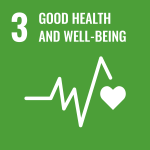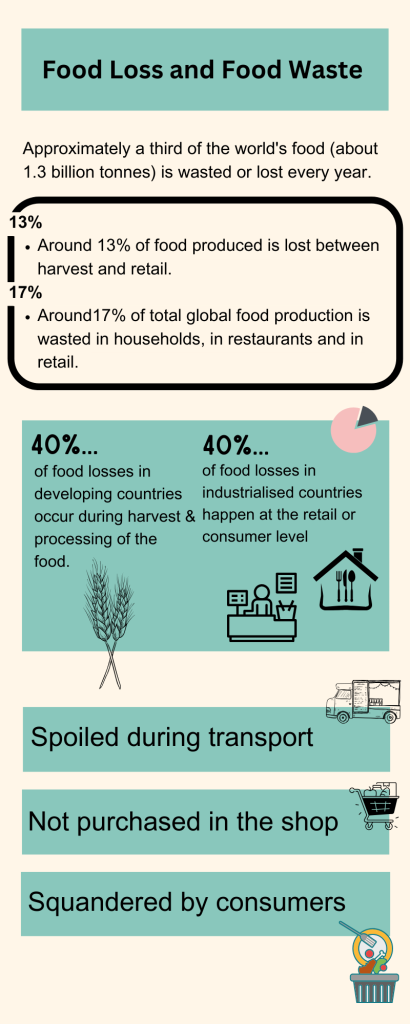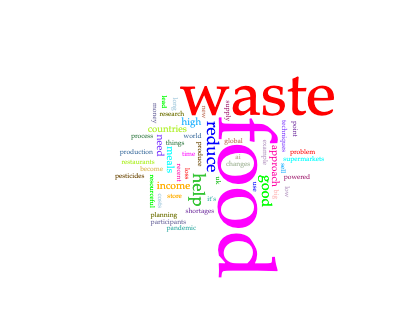Unit 14 Food: SDG3
Good Health and Well-being

Goal no. 3 of the 2030 Agenda for Sustainable Development aims to ensure healthy lives and promote well-being for all at all ages.
Click on the arrows to reveal more information about SDG3. You don’t need to remember everything you read – the main thing is to get an overview of this Goal.
Information and targets reproduced under the terms and conditions of United Nations websites. Copyright (2023).
A reminder that links in this e-book do not open in a new tab. If you click on any link to a webpage, click the back button in your browser to return here.
Key vocabulary
Check that you know the meaning and the whole word family of these key words before you begin the Unit. (NB there may be other versions of the word forms – these are the common forms in the context of SDG3). Also notice some common collocations in bold in the ‘Why this goal? and ‘Targets’ sections above. Add any new words, word families or collocations that you would like to remember to your vocabulary book.
Verb Noun Noun person Adjective
To be healthy health/health care healthcare worker healthy/healthcare
To be diseased disease diseased
To prevent prevention preventative/preventable
To medicate medicine medic medical
To spoil spoilage spoiled
Introduction
In Unit 13 you learned about food insecurity and hunger. In this Unit you’ll focus on the amount of food that goes to waste, and establish further links between food insecurity and health and well-being.
Each year almost one third of food produced is wasted. Food may go uneaten due to food loss, which is unavoidable and occurs when food is spoiled before it reaches the consumer, or due to food waste, when food is thrown away (or squandered) by retailers and consumers. Food waste is completely avoidable. Not only could this wasted food fill many of the hunger gaps in the developing world (all the food produced but never eaten would be sufficient to feed two billion people), it also represents a waste of the world’s resources, adding to pressures on the environment. Globally each year:
- 82 billion cubic meters of water are lost.
- Crops from 2.5 billion acres 1.4 billion of farmland are not eaten.
- 4 trillion megajoules of energy are wasted.
- $940 billion are lost.
- 3 billion tonnes of greenhouse gas emissions/CO2 are produced.
- Can you think of a link between climate change and food loss?
- Is food waste a feature of your local context? If yes, do you ever throw away food?
- What is your reaction to the statistics above about how much food goes uneaten?
Data visualisation – Food loss and food waste
Read the infographic and find the answers to the questions below (NB The ‘check’ box does not give you useful feedback, instead see the answers below the infographic).

Download the transcript here: Unit 14 Infographic
Listening – We throw away a third of the food we grow (8 mins)

Before you listen – Predict
- You’ll hear several suggestions for ways to reduce global food waste at every point in the process of producing and consuming it. Can you think of any ways of tackling food loss at these stages:
-
- When it is growing
- When it is harvested
- During transportation
- In the shops
- In people’s homes
- After it has been thrown away
- Look at the word cloud created from the transcript. The most frequently used words (the biggest ones in the cloud) are: food (50), waste (28), reduce (6), help (6), good (5). With the title in mind (‘We throw away a third of the food we grow’) create a sentence that uses as many of these words as possible and predicts the main point of the listening.

Listen
Narrated by Sue Robbins
Play the audio here
Download the transcript here: Unit 14 listening transcript
Pronunciation – Consonant clusters
As you learned in Unit 11, being able to say groups of consonants is one of the core pronunciation features which aids mutual understanding when a non-native speaker of English talks to another non-native speaker.
Focus on 2 or 3 consonant sounds or letters occurring together
- At the beginning of a word, consonant clusters consist of 2, and at most 3 consonant sounds.
- Examples of 2-consonant clusters at the beginning of a word: climate, prevent, spoil.
- 3-consonant clusters at the beginning of a word always begin with the letter ‘s’, e.g. strong, strike.
- Two- and three-consonant clusters can also appear between vowels, e.g. healthcare, mental, or at the end of a word, e.g. participant, understand, contexts.
- SDG3 aims to ensure healthy lives for all (3 consonant letters, but 2 consonant sounds – ‘l’, ‘th’)
- Retailers and consumers throw food away (3 consonant letters, but 2 consonant sounds – ‘th, ‘r’)
- Healthcare is not always available (4 consonant letters, but 3 consonant sounds – ‘l’, ‘th’, ‘c’)
- Global life expectancy (2 consonant letters, but 3 consonant sounds – ‘k’, ‘s’ ‘p’)
Practice
Listen to the four sentences. You’ll hear the sentence first and then just the word in bold that contains a consonant cluster. Listen and repeat the word.
Vocabulary – Collocations with food
In the listening you heard all of these common word partnerships with food:
food supply chain food shortages food waste food spoilage
food production food loss food producers (circular) food system
food ecosystem food security food insecurity
Practice
Reading – Food waste: using sustainable innovation to cut down what we throw away
Before you read
In this reading you’ll find out about innovative ways to cut down on the amount of food we throw away.
- In the listening you heard that high-income countries waste as much food as sub-Saharan Africa produces. With so many people in all parts of the world going hungry what do you think of the fact that developed nations regularly throw away so much food?
- Much of the waste is avoidable. If your context allows, do you take any measures in your household to avoid food waste?
- You’ll read case studies about 3 small businesses that are trying to deal with food waste in the supply chain. Their efforts help us think of waste as a valuable resource rather than something that needs to be thrown away. What term did you learn in Section 1 that describes the type of economy where waste is viewed this way?
- In Unit 2 you learned about the innovative way that coffee grounds are being used to create biofuel. Do you know of any innovative ways of reducing food waste that are being developed in your local context?
Skim read for main idea (max 3 mins)
- Read the heading ‘Food waste revolution start-ups’ and the first sentence, and predict what the innovative method of cutting down on the amount of food we throw away might be (a start-up is a newly established business).
- Read the heading ‘Anaerobic Digestion’ and the first 2 sentences, and predict what the innovative method of cutting down on the amount of food we throw away might be (anaerobic means not needing, or without oxygen).
- Read the heading ‘Burning and incineration’ and the first and last sentences in the section and find out why it is a poor idea to burn food that could have been consumed.
Read for detail
You’ll read case studies about 3 small businesses – Rejuce, Toast Ale, and Wyke Farm – that are trying to deal with food waste in the supply chain. You’ll also read about burning and incineration as a method of dealing with waste food.

Our appetite for food is a serious problem. The huge amount of energy, land and water used to fill our supermarket shelves mean that modern overproduction and excessive consumerism are rapidly depleting resources and damaging the planet.
Yet still, more than one third of the world’s food produce goes to waste every single year. This adds up to a staggering 1.3 billion tonnes of food, more than seven million tonnes of which is produced in the UK.
Now more than ever the survival of our food production is hinged on sustainable innovation. Here are some current ideas which attempt to effectively (or not so effectively) deal with food waste in the supply chain. We have given each type a “sustainability score” out of 20, based on five separate factors, including economic and environmental efficiency.
Food waste revolution start-ups
More than half of food waste in manufacturing and farming is classed as ‘avoidable’ and accounts for £1.4 billion of losses in the UK. This has inspired a range of small businesses which use this waste to make new products.
London-based former chef Tom Fletcher, for example, founded Rejuce in 2012 and since then has turned over 250 tonnes of ugly wonky fruit and veg into juices and smoothies. A network of suppliers provides the company with local and low-cost ingredients, eliminating their own disposal costs in the process.
Rejuce has been able to grow – now selling more than 100,000 bottles a year – by saving edible food from going to waste and turning it into nutritious products.
Meanwhile Toast Ale is a non-profit organisation which makes alcoholic drinks, including pale ales and craft lagers, from waste bread. It sources around 13,000 slices of bread discarded daily by sandwich manufacturers.
The byproduct of brewing is then processed and given to local farms for use as a highly nutritious animal feed. Selling online and through major British supermarkets Tesco and Waitrose, Toast Ale donates all its profits to Feedback, a charity working to transform the global food system.
These businesses – and many others – are reshaping the way we perceive and use waste as a value adding resource, rather than something that needs to be thrown away.
Sustainability score: 20
Anaerobic Digestion
Anaerobic digestion (AD) facilities provide renewable energy and gas. Wyke Farms, one of the leading dairy manufacturers in the UK, is using this approach to power its factories. Its biogas digester plants break down organic matter from farmyard manure, cheese making, cider mills and bakeries into natural energy.
This electricity is then used to power manufacturing sites, and the additional power is fed back into the grid to provide clean electricity for the local community. Not only does this save enormous amounts on energy bills every year, but it also reduces waste generation from manufacturing, lowering methane emissions.
It does not stop there. The leftover material from AD plants are excellent fertilisers which are used on Wyke Farms land and given to local farmers to boost soil fertility. The company also collaborates with its suppliers to implement sustainable approaches that reduce environmental impacts and save money.
But AD does bring some challenges. It requires a large initial investment and might prevent further innovation in dealing with byproducts of farming and manufacturing.
Sustainability score: 17
Burning and incineration
Burning food is not good for the environment as it releases carbon dioxide into the atmosphere. There are also concerns over the health implications of incinerators due to their weak pollution monitoring systems.
A report published by the Green Party showed an increase of 5.5m tonnes of waste sent for incineration in the UK between 2012 and 2017, adding up to over 10m tonnes. With stagnating recycling and composting rates at around 11m tonnes in this period, in some areas more waste is being incinerated than recycled. When examining a company, one should check how much burning contributes to their lower levels of waste.
Burning, incineration and AD are themselves energy consuming and costly. We could benefit from the energy that is generated through these methods, if the appropriate waste stream is used (non-recyclable waste, farmyard manure). But using recyclable or avoidable food waste which could be repurposed is a sheer waste of resources, time and labour that has gone into growing and processing food.
Sustainability score: 6
Overall, as a business case, sustainable innovation is intrinsically sound. It reduces waste and lowers environmental impacts as well as saving millions each year through increasing supply chain efficiency.
More importantly, it is an organisational culture that encourages activities and ideas that increase environmental and financial efficiency and prevents false claims that fail to do so. Of course, there will be businesses which attempt to jump on the bandwagon, making false claims about sustainability and the environmental impact of their operation.
One way to differentiate between “revolution” vs “bandwagon” start-ups is to demand ever greater transparency and question where companies source their raw materials. As consumers it is our responsibility to ask questions and hold brands accountable in their use of sustainable innovation.
NB This version of the article, with permission from the author, does not include the hyperlinks to supporting articles found in the original. Click the title for the full version of the text, published under a CC BY ND licence in The Conversation, which should be used for reference and sharing.
Download the answers here: Unit 14 reading answers
Function – Causality
- In Unit 1 you learned some structures to demonstrate causality, when one thing (X) causes or affects another thing (Y). How many can you recall?
- In the listening you heard that ‘Cosmetic blemishes, produce that is too ripe, too big, too little or even the wrong shape can lead to perfectly good fruits and vegetables going to waste’. In this sentence you can see the ‘X can lead to Y’ structure that describes causality – produce that is the wrong shape (X) can lead to food going to waste (Y).
Focus on causality
Here are more constructions that describe causality:
X can lead to Y
X may cause Y
X may result in Y
X can give rise to Y
X is a consequence of Y
X is a key factor in Y
X is a major influence on Y
X has a positive effect on Y
X has a significant impact on Y
Practice
Read the six sentences from the text and think about a link between them and world hunger, or efforts to alleviate hunger. For example:
- More than one third of the world’s food produce goes to waste every single year -> The fact that more than one third of the world’s food produce goes to waste every single year is a key factor in world hunger.
Write five more sentences that establish a causal link between food waste and hunger, using one of the structures in bold above.
- More than one third of the world’s food produce goes to waste every single year.
- Waste food adds up to a staggering 1.3 billion tonnes of food per year.
- More than half of food waste in manufacturing and farming is classed as ‘avoidable’ and accounts for £1.4 billion of losses in the UK.
- Rejuce has been able to grow – now selling more than 100,000 bottles a year – by saving edible food from going to waste and turning it into nutritious products.
- Toast Ale is a non-profit organisation which makes alcoholic drinks, including pale ales and craft lagers, from waste bread. It sources around 13,000 slices of bread discarded daily by sandwich manufacturers.
- Using recyclable or avoidable food waste which could be repurposed is a sheer waste of resources, time and labour that has gone into growing and processing food.
Writing – Letter
Using the information you have gained about food insecurity and hunger from Unit 13, and about the amount of food that goes to waste in the developed world and ways to tackle it in this Unit, write a letter to your local elected government official that gives your opinion on what your government and other governments around the world could/should be doing to help meet the aims of SDG2 Zero Hunger, and SDG3 Good Health and Well-being.
Speaking
Read the summary and answer the questions that follow.
SDG3 Summary
A clean environment is essential for human health and well-being. On the other hand, air and water pollution as well as poor management of hazardous chemicals and waste contribute to undermine health. Natural disasters and environmental shocks can have substantial impact on health, including deaths, injuries, diseases, disabilities, psychosocial problems and other indirect effects with damage to health facilities and disruption to the delivery of health services over extended periods of time.
Reproduced with kind permission of the UN Environment Programme. Copyright (2023). All rights reserved.
- Natural disasters and environmental shocks contribute to food loss in the developing world. Can you think of other ways that climate change is affecting health and well-being worldwide?
- Can you give a definition for the term in bold above?
A reminder that if you have access to the internet and are studying by yourself without other people to practice your spoken English with, you can use artificial intelligence (AI) to gain fluency practice. See here for instructions and prompts.
Here are some prompts related to this Unit:
- ‘Let’s have a dialogue about food loss and food waste. Tell me about food waste in [insert name of country] and how much food is squandered each year. Ask me my opinion about any information you give me.’
- ‘Let’s have a conversation about food loss in [insert name of country]. Let’s talk about climate change and how it is affecting the production of food there.’
Extension activities
After every two Units you are offered a choice of extension tasks. Use the menu bar on the left-hand side of the screen to access Extension Activities Units 13 and 14.
Looking Ahead to Unit 15
In Unit 15 you’ll learn about the way climate change is affecting all life on earth, and establish links between climate and health.
- What impacts of the effects of climate change to life on Earth can you think of?
- Can you think of any ways that climate change is affecting people’s health?

